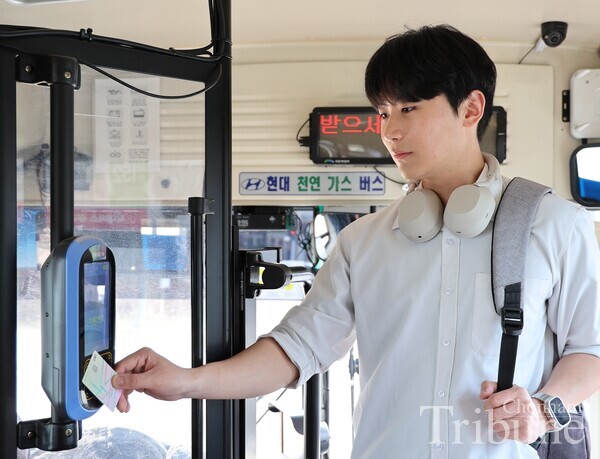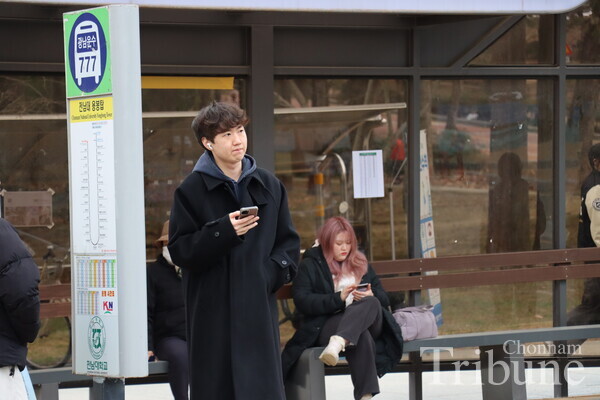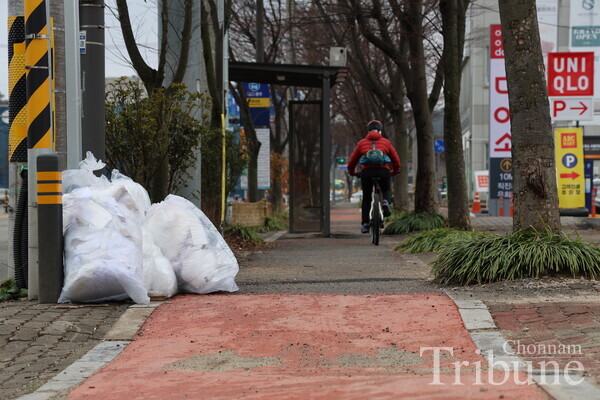
Gwangju Metropolitan City declared its transition to a “Public Transit, Biking, and Walking” city in 2023. Since then, it has made efforts to implement policies aimed at transforming the city from being car-oriented to eco-friendly, encouraging people to take a bus, bike or walk instead of driving. However, reports from the Korea Transportation Safety Authority show that Gwangju has the second-lowest public transit usage rate among Korea’s 17 administrative regions, as well as one of the lowest satisfaction rates among its seven metropolitan cities. This indicates that Gwangju’s residents are vulnerable to the inconveniences of the public transit system. Thus, the Chonnam Tribune examined Gwangju’s transportation system and issues related to the inconvenience residents experience when using buses, bicycles, and the subway in this city.
Bus Routes and Intervals
Gwangju operates a city bus system that is a semi-public system, where the city controls routes and infrastructure, while private companies handle operations. With national funds and an additional 140 billion won provided by the city, there are 14 private companies operating city buses, handling 113 routes and 2,369 stops. However, Gwangju residents reported the slowest relative bus travel speed among Korea’s major metropolitan cities. According to research released by the Korea Railroad Research Institute, Gwangju’s public transportation takes two to four times longer than cars in 59.05 percent of major districts.
The first challenge is long bus intervals. For instance, Route 777, the only bus linking several parts of Gwangju’s Buk District directly to Chonnam National University (CNU), has intervals of up to 20 minutes on weekdays. Kim Ji-an (Sophomore, Dept. of French Language and Literature) said, “I am satisfied with the 777 bus route because it connects two different districts, but its intervals are too long. I wish the city would adjust the bus intervals to better meet bus users’ demands.” This issue stems from a shortage of operating buses. As of January 2025, the city operates 999 buses, a slight increase from 965 buses in 1993. Considering the significant urban expansion that has occurred, the bus fleet has not kept pace with the city’s growth.

Outdated bus routes are another issue. Since 2017, the city’s bus network has seen minimal improvements, failing to accommodate new developments including apartment complexes. For instance, Im-dong S-Class Centum Park, only two kilometers away from CNU, takes approximately 40 minutes by bus versus 10 by car. The city’s public transportation department told the Tribune last February, “Large-scale bus route reforms were not implemented due to budget constraints, but the city has continuously completed limited-scale bus route reforms. We have a plan to make larger reforms with the opening of the new subway line.”
Insufficient budget allocation is a major cause of the public transit issues. In 2024, 61.1 billion won were invested into the expansion of seven different arterial road projects and 11 urban road projects. As a result, the city’s promise to prioritize public transport, cycling and walking became an empty slogan. Improvements to the bus system were deprioritized, while infrastructure for drivers was enhanced.

The Subway Line
The city’s only subway line, constructed in 2004, fails to meet resident’s needs due to its limited connections to key destinations, such as the bus terminal and major university districts. While the subway’s punctuality and speed are its biggest advantages, residents face the inconvenience of transferring to buses or taxis to reach their destinations. Na Hyeon-ho (Senior, Faculty of Business Administration) said, “It is inconvenient to use subways in the city. It feels like the subway infrastructure does not satisfy transportation demand. I believe the city needs to construct more subway lines.”
Compared to subway systems in other metropolitan cities, Gwangju’s line (20.5 km) falls short. In contrast, Busan has four lines (116.6 km), Daegu has three lines (87.17 km), and Incheon operates two lines (59.4 km). Experts emphasize the necessity of expanding Gwangju’s subway network as a critical component of an eco-friendly public transportation system (with buses, bicycles, and pedestrian paths), a goal that the city is actively promoting. According to a survey released by Newsis on Oct. 24, 2024, 30.7 percent of respondents prioritized subway line expansion to shift Gwangju’s transportation system away from cars and toward public transportation, cycling and walking.
Residents’ desire for a more expansive metro system is nothing new. After over a decade of consultations, the city officially inaugurated its plans for a second subway line in 2019, designed to circle through main areas such as City Hall, Chosun University, and CNU. This new plan is expected to help increase the share of citizens using public transportation. Kim Young-ji (Junior, Department of Public Administration) said, “I think the new subway line will provide more conveniences to the residents. The current subway line does not pass through universities, and I think opening the subway near universities like CNU would improve subway accessibility.” However, the new construction remains incomplete and is scheduled to open in phases between 2026 and 2030. Consequently, residents will continue to endure inconvenience until at least 2026.
Bicycles as an Alternative to Mass Transit
While the local bus system remains inadequate for long distances, it still serves a purpose across districts. For short-distance travel, however, buses are far less effective than bicycles. Some people utilize bicycles to navigate between alleys and reach destinations that are not accessible by buses. Moreover, there is no wait for bicycles. Despite these advantages, bicycles are account for only two percent of transportation usage in Gwangju. This low usage rate comes from inadequate infrastructure.

Nearly 80 percent of bicycle lanes are shared with pedestrians, and many of the bicycle-exclusive lanes are disconnected or obstructed. Shared lanes make riders vulnerable to potential dangers like pedestrian collisions and slow transit speed. Kwon Tae-seong, an official of Gwangju’s road division, explained budget difficulties related to the bicycle lanes. “We need to consider the financial efficiency of bicycle-exclusive lanes. Converting the lanes dedicated to bicycle lanes would be ideal, but the city must consider budget limitations.” As a result, the city’s budget priorities prevent constructing bicycle-exclusive lanes for an alternative mode of transit.
Furthermore, bicycle rental services are limited. In January 2025, Kakao T Bike, a major bicycle rental service, withdrew its business from Gwangju due to low profitability. Gwangju’s public bicycle rental service, “Tarangge,” was discontinued in October 2024 due to operational issues, having had only 350 bikes available and limited pick-up/drop-off areas.
As a result, Tarangge’s turnover rate (that is, the number of times an average bike was used per day) was 0.21 in 2023 and 1.34 in 2024. Despite bicycles being a useful transit option, limited infrastructure and services hinder their use. Additionally, the service was only available for six months a year, from April to September. Kwon noted, “Because Tarangge was a pilot project, the service was only offered for a few months. We identified the high-demand seasons and made the service available for those seasons.”
Improving Transportation Accessibility
“Few companies want to operate shuttle buses due to budget deficits. For this reason, we have no choice but to shrink the number of operating buses in the city,” said Gu Seongmu, an official of the Buk-gu Transportation Administration Division. Gwangju’s officials acknowledged the transit challenges faced by the city’s residents, but they said that it is difficult to set budget priorities. Allocating funds into one project limits opportunities for others. This is a major problem for a city where nearly half of people’s transportation depends on personal vehicles. It is a struggle to set priorities between drivers and bus users.
For instance, the Gwangcheon area, a key construction area for the Art & Culture Park, is set to be a testing site for the central bus lane system. This initiative is intended to shift the city from being car-oriented to bus-oriented. However, the plan also includes constructing an eight-lane roadway, building four new roads, and expanding six surrounding roads. The city continues to prioritize policies that favor private vehicle drivers, fearing increased congestion in this area. This creates a vicious cycle, where neither problem is fully addressed. Frustrated drivers push for road expansions, while existing transportation problems remain unresolved.
The key to breaking this cycle is reducing the financial burden on public transit users. Making public transit more accessible and affordable can reduce the number of cars on the road. For instance, Hwaseong City introduced free bus rides for its residents in 2020, and the strategy has delivered significant results. As bus usage has increased, the number of cars on the road has decreased. Average monthly bus ridership reportedly increased four-fold, from 7,714 in 2020 to 32,773 in 2023, while the average monthly number of passengers per bus also surged nearly eightfold, from 482 to 3,028. According to a report released by the Institute for Green Transformation, the introduction of free rides resulted in a reduction of over 4.3 million cars during those two years.
For this reason, Gwangju launched the G-Pass service in January 2025 to increase public transit use. Under this strategy, adolescents under 18 receive 50 to 100 percent fare rebates, and adults between 19 and 39 years old receive 30 percent. Along with this initiative, the city needs to provide financial support to get more people using public transit. The more people choose more sustainable options like cycling and buses over cars, the less demand for road expansions will exist. If this is realized, the city can create enough financial resources to make public transit an attractive option.
Additionally, following a public hearing, Gwangju’s third subway line, called “Gwangcheon Sangmu,” is expected to begin development in earnest this year. This line will feature seven stations, including Sangmu Stationand Gwangju Station. Gwangju is also planning to resume its public bike system, Tarangge in the near future. “We think expanding the infrastructurefor biking in the city will raise the bike rental rate like Daejeon. Thus, we are attempting to make plans to achieve that,” an official of the Road Division said. The city also plans to expand its service areas to universities. The public bike system’s return is expected to increase the number of bike riders, providing more adequate infrastructure for the city’s residents.
Resolving Deeply Rooted Problems
Reducing the financial burden of public transit and expanding bicycle services are only temporary solutions. The city needs to develop comprehensive and long-term plans to resolve the deeply rooted problems. City officer Kwon said, “From the outset, the city was designed with cars in mind. Public transit and bicycles, once considered secondary, are newer concepts that have gained popularity in recent years due to climate change. Expanding rental services and providing financial support are only temporary measures. The city’s design is still unsuitable for bicycles and public transit. Gwangju needs to learn from other cities with more effective public transit and bicycle infrastructure. The city must reform itself aggressively to achieve permanent improvements.
People in their 20s are responsible for 18 percent of public transit usage, according to the Korea Transportation Safety Authority, making it the third-largest portion among all age groups. They also had the lowest car purchase rate in 2024, indicating that university students are more dependent on public transit than other age groups. By developing more comprehensive and long-term plans, the city will not only take great steps forward, but allow its residents, especially university students, to experience Gwangju as a more sustainable, satisfying and enjoyable city.
By Kim Jong-hyo, Editor

